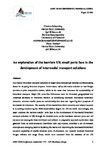An exploration of the barriers UK small ports face in the development of intermodal transport solutions
| dc.contributor.author | Scheuring, F | |
| dc.contributor.author | Karamperidis, Stavros | |
| dc.contributor.author | Borisov, V | |
| dc.date.accessioned | 2018-09-27T10:47:15Z | |
| dc.date.issued | 2018-09-14 | |
| dc.identifier.uri | http://hdl.handle.net/10026.1/12425 | |
| dc.description.abstract |
Intermodal hinterland transport solutions of major ports increasingly become a differentiating factor for shipping lines and shippers. Furthermore, rail as alternative solution to road freight provides a price competitive option, which at the same time increases the sustainability of hinterland transport. Major UK ports like Felixstowe have the financial, geographical and relational attributes to overcome barriers of developing extensive intermodal hinterland networks, whereas smaller ports are considerably less fortunate regarding their prospects of intermodal development. The scarcity of intermodal hinterland networks and related research is surprising considering the 2050 sustainability targets the UK set itself. Accordingly, this paper explores the barriers smaller ports face in the development of intermodal hinterland transport solutions in UK through the Scottish ports, as the interfaces between ports and rail transport are among the least developed and utilised. A pragmatist approach synthesised data gathered from 10 semi-structured interviews with key experts, identified a set of common concepts and emerging patterns depicting the barriers to improving the intermodal hinterland transport capability of smaller Scottish ports. Furthermore, our research analysed historical freight volumes and cargo flows, which were extracted from the database of the UK Department for Transport. Preliminary findings of our research show that environmental impact, is of minor importance. However, infrastructure requirements and volumes are of major concern to independent supply chain actors involved in the development of intermodal hinterland transport solutions. The paper concludes by outlining an agenda for further research and recommends actions for smaller ports on how to overcome barriers to developing their intermodal network. | |
| dc.language.iso | en | |
| dc.rights | Attribution-NonCommercial-NoDerivatives 4.0 International | |
| dc.rights | Attribution-NonCommercial-NoDerivatives 4.0 International | |
| dc.rights | Attribution-NonCommercial-NoDerivatives 4.0 International | |
| dc.rights | Attribution-NonCommercial-NoDerivatives 4.0 International | |
| dc.rights | Attribution-NonCommercial-NoDerivatives 4.0 International | |
| dc.rights | Attribution-NonCommercial-NoDerivatives 4.0 International | |
| dc.rights.uri | http://creativecommons.org/licenses/by-nc-nd/4.0/ | |
| dc.rights.uri | http://creativecommons.org/licenses/by-nc-nd/4.0/ | |
| dc.rights.uri | http://creativecommons.org/licenses/by-nc-nd/4.0/ | |
| dc.rights.uri | http://creativecommons.org/licenses/by-nc-nd/4.0/ | |
| dc.rights.uri | http://creativecommons.org/licenses/by-nc-nd/4.0/ | |
| dc.rights.uri | http://creativecommons.org/licenses/by-nc-nd/4.0/ | |
| dc.title | An exploration of the barriers UK small ports face in the development of intermodal transport solutions | |
| dc.type | conference | |
| plymouth.date-start | 2018-09-11 | |
| plymouth.date-finish | 2018-09-14 | |
| plymouth.conference-name | International Association of Maritime Economists | |
| plymouth.organisational-group | /Plymouth | |
| plymouth.organisational-group | /Plymouth/Faculty of Arts, Humanities and Business | |
| plymouth.organisational-group | /Plymouth/REF 2021 Researchers by UoA | |
| plymouth.organisational-group | /Plymouth/REF 2021 Researchers by UoA/UoA17 Business and Management Studies | |
| plymouth.organisational-group | /Plymouth/Users by role | |
| plymouth.organisational-group | /Plymouth/Users by role/Academics | |
| dc.publisher.place | Mombasa | |
| dcterms.dateAccepted | 2018-08-24 | |
| dc.rights.embargodate | 2022-10-18 | |
| dc.rights.embargoperiod | Not known | |
| rioxxterms.licenseref.uri | http://creativecommons.org/licenses/by-nc-nd/4.0/ | |
| rioxxterms.licenseref.startdate | 2018-09-14 | |
| rioxxterms.type | Conference Paper/Proceeding/Abstract |



